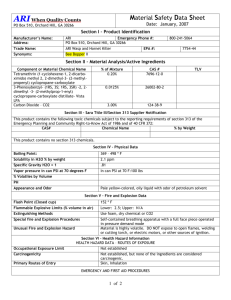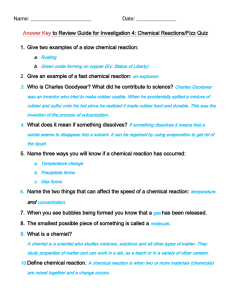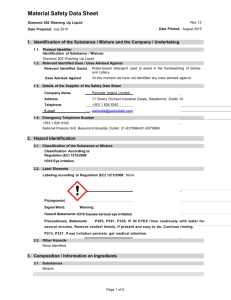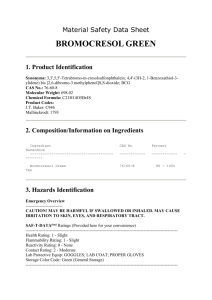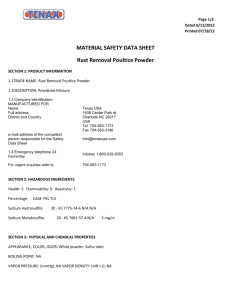SAFETY DATA SHEET - Pro Guard Coatings
advertisement
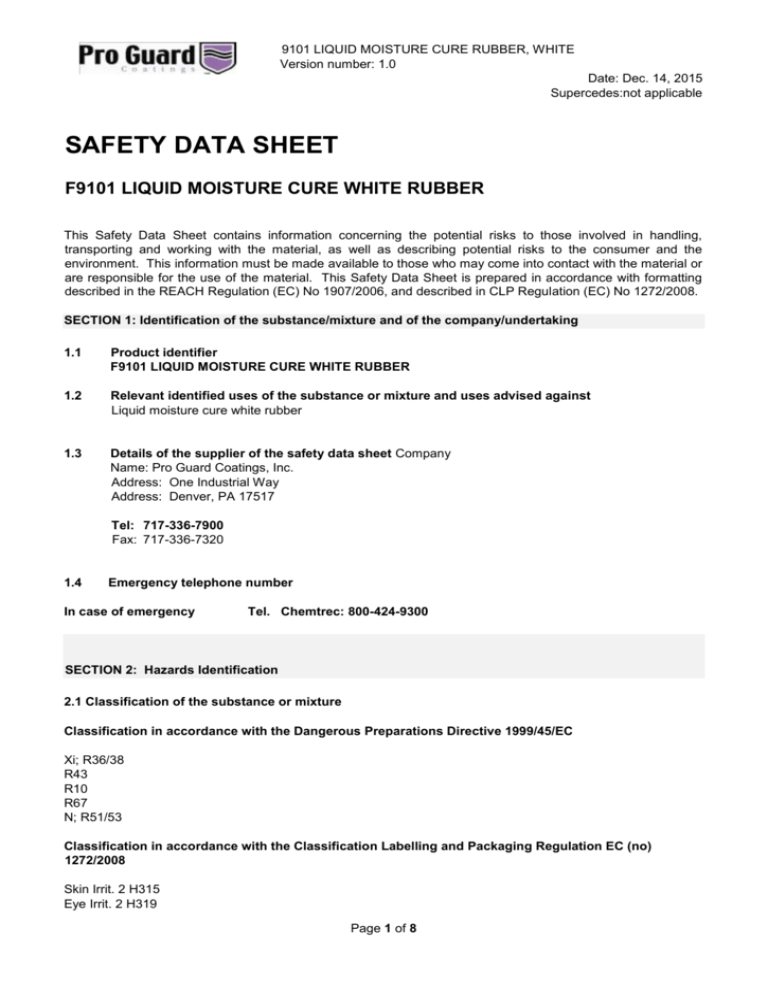
9101 LIQUID MOISTURE CURE RUBBER, WHITE Version number: 1.0 Date: Dec. 14, 2015 Supercedes:not applicable SAFETY DATA SHEET F9101 LIQUID MOISTURE CURE WHITE RUBBER This Safety Data Sheet contains information concerning the potential risks to those involved in handling, transporting and working with the material, as well as describing potential risks to the consumer and the environment. This information must be made available to those who may come into contact with the material or are responsible for the use of the material. This Safety Data Sheet is prepared in accordance with formatting described in the REACH Regulation (EC) No 1907/2006, and described in CLP Regulation (EC) No 1272/2008. SECTION 1: Identification of the substance/mixture and of the company/undertaking 1.1 Product identifier F9101 LIQUID MOISTURE CURE WHITE RUBBER 1.2 Relevant identified uses of the substance or mixture and uses advised against Liquid moisture cure white rubber 1.3 Details of the supplier of the safety data sheet Company Name: Pro Guard Coatings, Inc. Address: One Industrial Way Address: Denver, PA 17517 Tel: 717-336-7900 Fax: 717-336-7320 1.4 Emergency telephone number In case of emergency Tel. Chemtrec: 800-424-9300 SECTION 2: Hazards Identification 2.1 Classification of the substance or mixture Classification in accordance with the Dangerous Preparations Directive 1999/45/EC Xi; R36/38 R43 R10 R67 N; R51/53 Classification in accordance with the Classification Labelling and Packaging Regulation EC (no) 1272/2008 Skin Irrit. 2 H315 Eye Irrit. 2 H319 Page 1 of 8 9101 LIQUID MOISTURE CURE RUBBER, WHITE Version number: 1.0 Date: Dec. 14, 2015 Supercedes:not applicable Skin Sens. 1 H317 STOT SE Cat. 3 H336 Aquatic Chronic Cat, 2 H411 Flammable Liquid Cat. 3, H226 2.2 Label elements Labelling in accordance with the Classification Labelling and Packaging Regulation EC (no) 1272/2008 WARNING H315 Causes skin irritation H319 Causes serious eye irritation H317 May cause an allergic skin reaction P280 Wear protective gloves/protective clothing/eye protection/face protection. H336 May cause drowsiness or dizziness P302 + P352 IF ON SKIN: Wash with plenty of soap and water. P333 + P313 If skin irritation or rash occurs: Get medical advice/attention. P305 + P351 + P338 IF IN EYES: Rinse cautiously with water for several minutes. Remove contact lenses, if present and easy to do. Continue rinsing. P501 Dispose of contents/container as hazardous waste P210 Keep away from heat/sparks/open flames/hot surfaces – no smoking P271 Use only outdoors or in a well ventilated area P403 + P233 Store in a well ventilated area 2.3 Other hazards No physical hazards are anticipated. Expected to be irritant. Contains components which are considered to be toxic to aquatic organisms. None of the components are considered to be Persistent, Bioaccumulative and Toxic (PBT) or very Persistent, very Bioaccumulative (vPvB). SECTION 3: Composition 3.1 Substances Not applicable, product is a mixture. 3.2 Mixtures A mixture of polymers, solvents and additives. Name CAS No. Classification N/A Concentration % w/w >25% Polyester Resin Modified N/A <5.0% Not Classified Hydroxy terminated linear polyester polyol Page 2 of 8 Not Classified 9101 LIQUID MOISTURE CURE RUBBER, WHITE Version number: 1.0 Date: Dec. 14, 2015 Supercedes:not applicable 4-Chloroalpha…alpha…alpha trifluorotoluene 98-56-6 >20.0% Xi; R36/38, R43 DSD 67/548/EEC Skin Irrit. 2 H315, Eye Irrit. 2 H319 Skin Sens. 1 H317 CLP 1272/2008 See section 16 for full description of R phrases and H statements. SECTION 4: First Aid Measures 4.1 Description of first aid measures EYE CONTACT: Rinse thoroughly with water for several minutes, whilst gently holding the eyelids open. Obtain medical attention if signs of discomfort. INHALATION: Remove from exposure and keep warm and at rest. If breathing becomes difficult call a doctor. If breathing stops, begin artificial respiration and seek immediate medical attention. SKIN CONTACT: Remove contaminated clothing. Wash off with soap and water. Seek medical attention if irritation occurs. Wash contaminated clothing before re-use. INGESTION: If swallowed, rinse mouth with water. Do NOT induce vomiting. If vomiting occurs, keep head below hips to prevent aspiration of liquid into the lungs. Seek immediate medical attention. 4.2 Most important symptoms and effects, both acute and delayed EYES: Redness, watering INHALATION: Irritation of the mouth, nose and throat, coughing. INGESTION: Irritation of the mouth and throat. Nausea, discomfort. SKIN: Redness, irritation, rash. Chronic exposure may result in allergic skin reactions. 4.3 Indication of any immediate medical attention and special treatments needed Symptomatic treatment as required SECTION 5: Firefighting Measures 5.1 Extinguishing media Small fires: Foam, CO2, dry chemical Large fires: Water fog, foam, CO2, dry chemical 5.2 Special hazards arising from the substance or mixture Decomposition products will include oxides of carbon and nitrogen, incomplete combustion products. 5.3 Advice for fire fighters Prevent run-off from fire from entering water courses and sewers. Firefighters should use standard protective equipment and in enclosed spaces, positive pressure self-contained breathing apparatus (SCBA). Use water spray to cool fire exposed containers. SECTION 6: Accidental Release Measures 6.1 Personal precautions, protective equipment and emergency procedures Remove all ignition sources and evacuate unnecessary personnel from the area. Ventilate the area if possible. Wear suitable protective clothing including solvent resistant gloves and coveralls. If vapour concentrations are high, respiratory protective equipment may be required. See section 8 for more information. Page 3 of 8 9101 LIQUID MOISTURE CURE RUBBER, WHITE Version number: 1.0 Date: Dec. 14, 2015 Supercedes:not applicable 6.2 Environmental precautions Prevent entry into sewers and watercourses. If product enters sewers or watercourses, inform the appropriate environmental authorities. 6.3 Methods and materials for containment and clearing up Small spills: Remove all ignition sources. Absorb spillage in a non-combustible absorbent, e.g. sand or vermiculite, and place in a suitable container for disposal. Large spills: Remove all ignition sources. Contain spill and cover if possible to reduce evaporation. Mix spillage with a suitable non-combustible absorbent, e.g. sand or earth, and place in a suitable container for disposal. 6.4 References to other sections See sections 8 and 13 for further advice on protective clothing and disposal. SECTION 7: Handling and Storage 7.1 Precautions for safe handling Avoid contact with skin and eyes. Use only in well ventilated areas. Avoid contact with all ignition sources, including hot surfaces. 7.2 Conditions for safe storage, including any incompatibilities Store in a well ventilated, bonded area, away from all ignition sources. Keep out of direct sunlight. Vapours are heavier than air and may accumulate in low lying areas and below ground areas such as ducts and sewers. 7.3 Specific end uses(s) No industrial or sector specific guidance available. SECTION 8. Exposure Controls/Personal Protection 8.1 Control parameters No exposure limits available. 8.2 Exposure controls Engineering controls Adequate ventilation should be provided so that exposure limits are not exceeded. Use explosion-proof ventilation equipment. Respiratory protection Use only in well ventilated area. If exposure levels are likely to exceed the OEL then suitable respiratory protection will be required. Hand Protection Wear suitable chemical resistant gloves recommended for use with hydrocarbon solvent. Nitrile gloves may be suitable, but glove manufacturers’ specifications should always be checked first. Natural rubber gloves are not suitable. Change gloves in accordance with manufacturer recommendations. If gloves are damaged during use, remove immediately and wash hands before replacing with new gloves. Eye protection Wear suitable eye protection, meeting the requirements of BS EN166 3, when handling this product. Page 4 of 8 9101 LIQUID MOISTURE CURE RUBBER, WHITE Version number: 1.0 Date: Dec. 14, 2015 Supercedes:not applicable Skin protection Aprons or coveralls are recommended. These should be changed after use or if contaminated. Wash before reuse. Environmental Exposure Controls Take suitable measures to prevent entry into drains, sewers and watercourses. SECTION 9: Physical and Chemical Properties 9.1 Information on basic physical and chemical properties Appearance: White viscous liquid Odor: Mild solvent odor Odor threshold: No data available pH: Not applicable Melting point: No data available Boiling point: No data available Flashpoint: 109°F Evaporation rate: No data available Flammability (gas, solid): Not applicable Upper/lower flammability limits Not applicable Vapor pressure: No data available Vapor density: Heavier than air Relative density: 11.2 lbs./gallon Solubility in water: Insoluble Solubility in other solvents: No data available Partition coefficient (log Kow): No data available Autoignition temperature: No data available Decomposition temperature: No data available Viscosity: No data available Explosive properties: Not classified as explosive Oxidizing properties: Not classified as oxidizing. 9.2 Other information VOC content: 12 g/l SECTION 10: Stability and Reactivity 10.1 Reactivity Not considered a reactive material. 10.2 Chemical stability This material is stable under expected conditions of use. 10.3 Possibility of hazardous reactions Hazardous polymerization will not occur. 10.4 Conditions to avoid Avoid heat, sparks, open flames and other ignition sources. 10.5 Incompatible materials Strong oxidizers. 10.6 Hazardous decomposition products Material does not decompose under normal conditions of use. See section 5 for fire decomposition products. Page 5 of 8 9101 LIQUID MOISTURE CURE RUBBER, WHITE Version number: 1.0 Date: Dec. 14, 2015 Supercedes:not applicable SECTION 11: Toxicological Information 11.1 Information on toxicological effects This product has not been tested. Judgements on the expected toxicity of this product have been made based upon consideration of its major components. (a) acute toxicity Not expected to be acutely toxic, based on consideration of the components. Acute Toxicity Estimate (ATE) > 2000 mg/kg (b) skin corrosion/irritation Expected to be irritating to skin, based on consideration of the components. (c) serious eye damage/irritation Expected to be irritating to eyes, based on consideration of the components. (d) respiratory/skin sensitization Expected to be sensitizing, based on consideration of the components. (e) germ cell mutagenicity Not expected to be mutagenic. (f) carcinogenicity Contains no components considered to be carcinogenic above thresholds of concern. (g) reproductive toxicity Contains no components considered to be hazardous to reproduction above thresholds of concern. (h) STOT-single exposure Not expected to cause organ damage. The solvents present may cause narcotic effects if inhaled or ingested in large quantities. (i) STOT-repeated exposure Not expected to cause organ damage from prolonged or repeated exposure. (j) aspiration hazard Not expected to be an aspiration hazard. SECTION 12: Ecological Information This product has not been tested. Judgements on the expected toxicity of this product have been made based upon consideration of its major components. 12.1 Toxicity This product contains components that are considered to be toxic to aquatic organisms and may cause longterm adverse effects in the aquatic environment. Once cured the toxicity of the product is expected to decrease. 12.2 Persistence and degradability This product is not expected to be readily biodegradable. 12.3 Bioaccumulative potential This product is expected to have a low bioaccumulation potential. 12.4 Mobility in soil Cured product is expected to be immobile. 12.5 Results of PBT and vPvB assessment None of the components are known to be PBT or vPvB. 12.6 Other adverse effects None known. Page 6 of 8 9101 LIQUID MOISTURE CURE RUBBER, WHITE Version number: 1.0 Date: Dec. 14, 2015 Supercedes:not applicable SECTION 13: Disposal Considerations 13.1 Waste treatment methods Recover and recycle product if possible. If recovery and recycling are not possible, dispose of by incineration. Empty containers may contain flammable residues. Do not puncture, cut or grind. Empty containers should be disposed of as hazardous waste. Disposal should be in accordance with local and national regulations. SECTION 14: Transport Information 14.1 UN Number 14.2 UN Proper shipping name 14.3 Transport hazard class(es) 14.4 Packing group 14.5 Environmental hazards 14.6 Special precautions for user 14.7 Transport in bulk according to Annex II of MARPOL 73/78 and the IBC Code ADR 1263 PAINT IMDG 1263 PAINT ICAO 1263 PAINT 3 3 3 III NONE III NONE III NONE NONE NONE NONE NONE NONE NONE SECTION 15: Regulatory Information 15.1 Safety, health and environmental regulations/legislation specific for the substance or mixture All components are listed as existing substances in Europe 15.2 Chemical Safety Assessment A Chemical Safety Assessment has not been carried out for this product. SECTION 16: Other Information Revision information: This is a new SDS. List of Abbreviations used in this SDS: CAS Chemical Abstracts Service CLP Classification, Labelling and Packaging Regulation (EC) no 1272/2008 DSD Dangerous Substances Directive 67/548/EEC DPD Dangerous Preparations Directive 1999/45/EC EC European Community/Commission PBT Persistent, Bioaccumulative and Toxic Page 7 of 8 9101 LIQUID MOISTURE CURE RUBBER, WHITE Version number: 1.0 Date: Dec. 14, 2015 Supercedes:not applicable REACH Registration, Evaluation, Authorization and Restriction of Chemicals Regulation (EC) no 1907/2006 vPvB very Persistent, very Bioaccumulative References: ECHA CHEM database Suppliers’ SDSs for component substances Method used for classification of mixtures: Ingredient based approaches R Phrases and H Statements used in Section 3 R10 Flammable R36/38 Irritating to eyes and skin R37 Irritating to respiratory system R38 Irritating to skin R43 May cause sensitization by skin contact R51/53 Toxic to aquatic organisms, may cause long-term adverse effects in the aquatic environment R65 Harmful: may cause lung damage if swallowed R66 Repeated exposure may cause skin dryness or cracking R68 Possible risk of irreversible effects H226 Flammable liquid and vapor H304 May be fatal if swallowed and enters airways H315 Causes skin irritation H317 May cause an allergic skin reaction H319 Causes serious eye irritation H335 May cause respiratory irritation H341 Suspected of causing genetic defects H411 Toxic to aquatic life with long lasting effects EUH066 Repeated exposure may cause skin dryness or cracking Training requirements for workers No special requirements. Page 8 of 8


